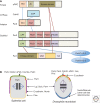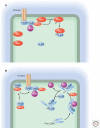Signaling pathways in cell polarity
- PMID: 22553378
- PMCID: PMC3367552
- DOI: 10.1101/cshperspect.a009654
Signaling pathways in cell polarity
Abstract
A key function of signal transduction during cell polarization is the creation of spatially segregated regions of the cell cortex that possess different lipid and protein compositions and have distinct functions. Polarity can be initiated spontaneously or in response to signaling inputs from adjacent cells or soluble factors and is stabilized by positive-feedback loops. A conserved group of proteins, the Par proteins, plays a central role in polarity establishment and maintenance in many contexts. These proteins generate and maintain their distinct locations in cells by actively excluding one another from specific regions of the plasma membrane. The Par signaling pathway intersects with multiple other pathways that control cell growth, death, and organization.
Figures






Similar articles
-
Crosstalk of cell polarity signaling pathways.Protoplasma. 2017 May;254(3):1241-1258. doi: 10.1007/s00709-017-1075-2. Epub 2017 Mar 14. Protoplasma. 2017. PMID: 28293820 Review.
-
Widely conserved signaling pathways in the establishment of cell polarity.Cold Spring Harb Perspect Biol. 2009 Aug;1(2):a001370. doi: 10.1101/cshperspect.a001370. Cold Spring Harb Perspect Biol. 2009. PMID: 20066082 Free PMC article. Review.
-
Par proteins and neuronal polarity.Dev Neurobiol. 2011 Jun;71(6):483-94. doi: 10.1002/dneu.20867. Dev Neurobiol. 2011. PMID: 21557502 Free PMC article. Review.
-
DLG5 connects cell polarity and Hippo signaling protein networks by linking PAR-1 with MST1/2.Genes Dev. 2016 Dec 15;30(24):2696-2709. doi: 10.1101/gad.284539.116. Genes Dev. 2016. PMID: 28087714 Free PMC article.
-
Phosphoinositide lipids and cell polarity: linking the plasma membrane to the cytocortex.Essays Biochem. 2012;53:15-27. doi: 10.1042/bse0530015. Essays Biochem. 2012. PMID: 22928505 Review.
Cited by
-
Regulation of Cell Polarity by Posttranslational Protein Palmitoylation.Methods Mol Biol. 2022;2438:107-121. doi: 10.1007/978-1-0716-2035-9_7. Methods Mol Biol. 2022. PMID: 35147938 Free PMC article.
-
Cytokinesis defines a spatial landmark for hepatocyte polarization and apical lumen formation.J Cell Sci. 2014 Jun 1;127(Pt 11):2483-92. doi: 10.1242/jcs.139923. Epub 2014 Apr 4. J Cell Sci. 2014. PMID: 24706948 Free PMC article.
-
CD13 orients the apical-basal polarity axis necessary for lumen formation.Nat Commun. 2021 Aug 4;12(1):4697. doi: 10.1038/s41467-021-24993-x. Nat Commun. 2021. PMID: 34349123 Free PMC article.
-
Transient laminin beta 1a Induction Defines the Wound Epidermis during Zebrafish Fin Regeneration.PLoS Genet. 2015 Aug 25;11(8):e1005437. doi: 10.1371/journal.pgen.1005437. eCollection 2015 Aug. PLoS Genet. 2015. PMID: 26305099 Free PMC article.
-
Human Immunodeficiency Virus (HIV) and Human Cytomegalovirus (HCMV) Coinfection of Infant Tonsil Epithelium May Synergistically Promote both HIV-1 and HCMV Spread and Infection.J Virol. 2021 Aug 25;95(18):e0092121. doi: 10.1128/JVI.00921-21. Epub 2021 Aug 25. J Virol. 2021. PMID: 34232730 Free PMC article.
References
-
- Baas AF, Kuipers J, van der Wel NN, Batlle E, Koerten HK, Peters PJ, Clevers HC 2004. Complete polarization of single intestinal epithelial cells upon activation of LKB1 by STRAD. Cell 116: 457–466 - PubMed
MeSH terms
Substances
Grants and funding
LinkOut - more resources
Full Text Sources
